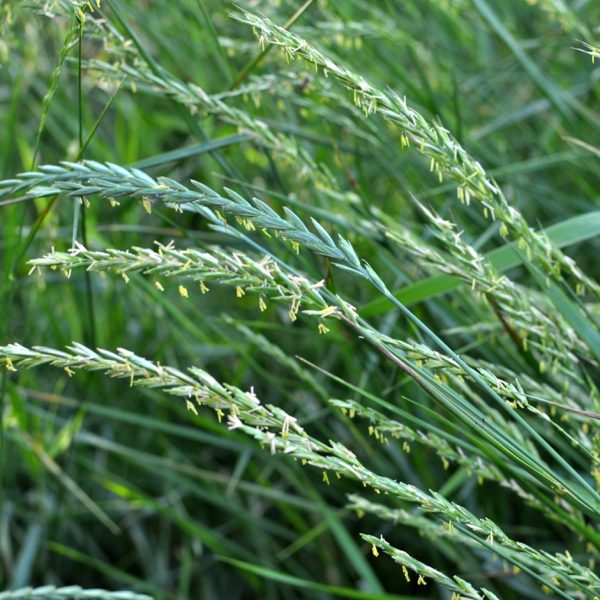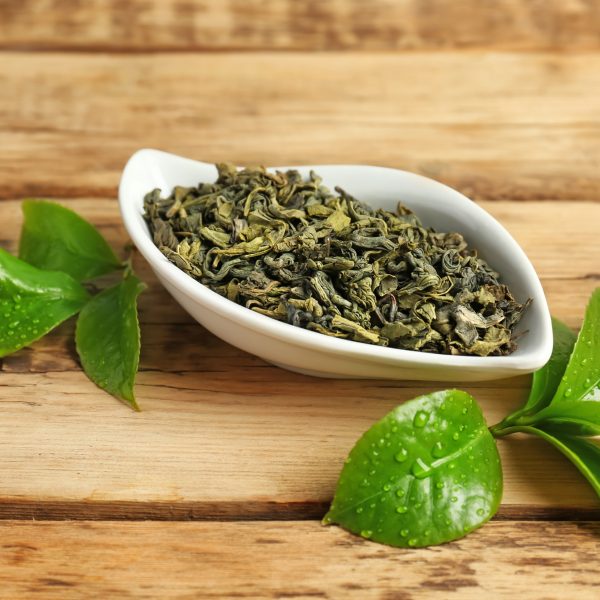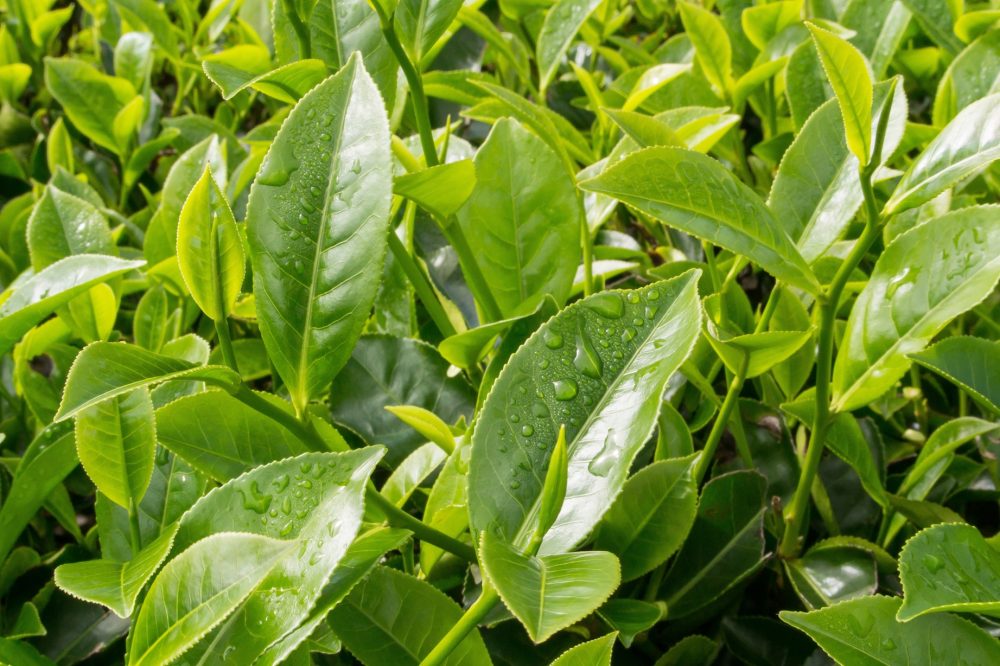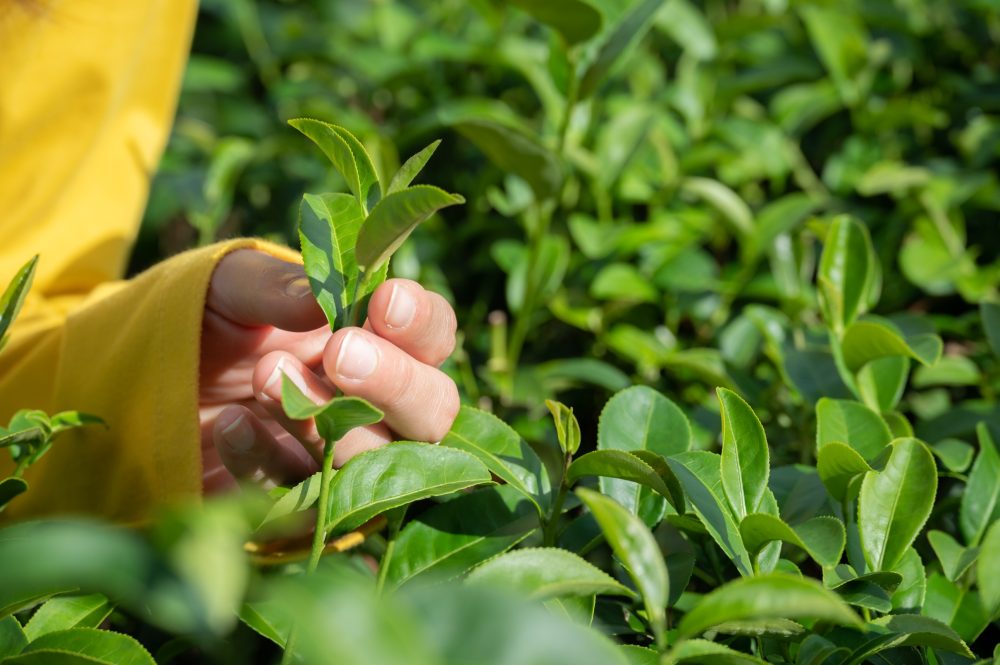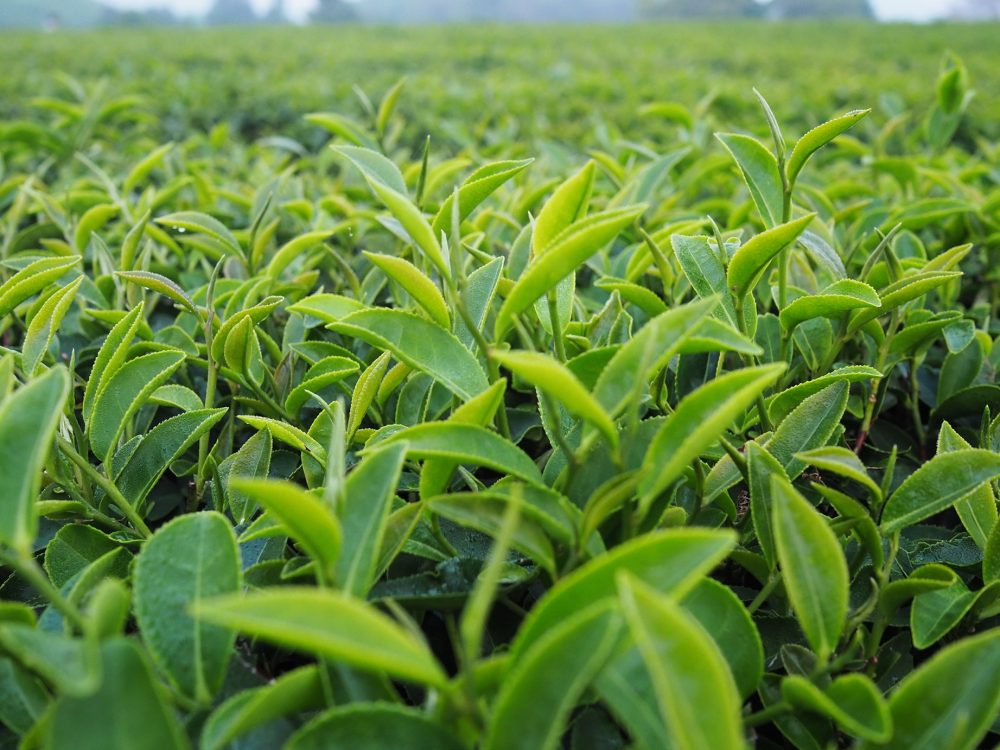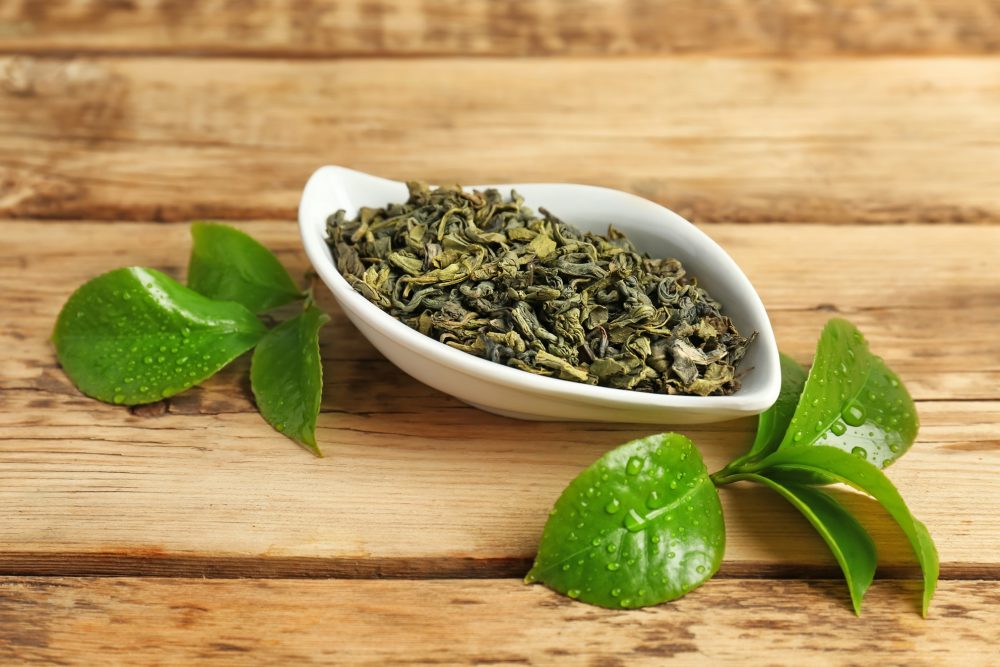-
How does it feel?
Source the finest quality green tea, for example a matcha blend, and in a cup, pour water on the tea just before boiling point. The colour of the water will move from an immediate greenish-yellow to a darker yellow-brown. Do not add milk or whitener. After five minutes take a sip and note the familiar dry, refreshing taste, only subtly aromatic. Even in hot weather, a cup of green tea offers a cooling and refreshing effect.
The flavour offers fresh grassy tones, with a slight astringency and a slight bitterness. The flavour profile can vary depending on the quality, and ranges from nutty and earthy qualities to a more umami and rich taste. The duration of time the tea has been steeped also affects the flavour, with a longer brew giving a more powerful bitter flavour.
-
What can I use it for?

Green tea (Camellia sinensis) Green tea can be enjoyed as a healthy and refreshing daily beverage. It has a multitude of health benefits and makes for a good coffee substitute, and may be better tolerated than black tea. There is some suggestion that it can be a useful part of a weight-loss regime due to its effect on supporting metabolism. Its myriad of health benefits are reflected in both its traditional usage and modern research. Consuming green tea as a beverage rather than a supplement or as part of a prescription is usually preferable due to practicality. It can easily be incorporated into a daily routine, either as a substitute or alongside coffee or black tea (1, 2).
For ongoing health problems it may best be seen as a long term health and wellbeing measure rather than a quick fix. It can be considered as a preventative to help protect the body against heart and circulatory diseases, late-onset diabetes or dementia. As a powerful antioxidant, the polyphenols offer cellular protection from oxidative stress as well as neutralising free radicals, resulting in decreased markers of cellular damage and inflammation (1). The polyphenols modulate immune function by impacting both innate and adaptive immune cells (3).
Green tea can support cardiovascular health by lowering total cholesterol levels and can be effective in preventing the risk of atherosclerosis and heart disease (4).
Green tea provides a moderate source of caffeine. Caffeine in this context can enhance cognitive function, increasing alertness and reducing brain fog. As a result, green tea can be applied to overcome fatigue and tiredness (1, 2).
-
Into the heart of green tea

Green tea (Camellia sinensis) Green tea is exceptionally high in flavonoids that can help improve cardiovascular health. The sensory qualities of green tea are bitter and astringent due to the high level of tannins (1).
The astringent qualities of green tea are ideal for the treatment of damp conditions. Green tea is a diuretic that promotes urination and fluid circulation which explains how it is able to remove dampness from the tissues.
It may be used to alleviate issues involving fluid stagnation and retention such as oedema, painful or difficult urination, urinary stones and phlegmatic conditions.
In traditional Chinese medicine (TCM) green tea is classified as a cold herb that strongly purges the body of fire – a more severe heat. This typically presents with symptoms in the upper body such as with febrile disease and other origins, resulting in high fever, red face and eyes, thirst, extreme headaches and pronounced irritability and possibly accompanied by delirium (5).
-
Traditional uses
Green tea has been an important part of Chinese, and later Japanese and Korean social life over almost two millennia. The earliest accounts of tea ceremonies come from China around 1200 years ago during the Tang Dynasty when the ritual of infusing and serving tea was part of a religious ceremony called cha dao or ‘the way of the tea’.
Outside China, tea was brought to Europe in the 16th century and became popular in Britain, with black tea overtaking green tea to become its most popular drink during the 18th century. It was initially promoted through tea houses as a tonic and health drink before becoming a popular beverage. The British East India Company introduced tea production, as well as tea consumption, to India, in order to compete with the Chinese monopoly on tea (6).
-
Traditional actions
Herbal actions describe therapeutic changes that occur in the body in response to taking a herb. These actions are used to express how a herb physiologically influences cells, tissues, organs or systems. Clinical observations are traditionally what have defined these actions: an increase in urine output, diuretic; improved wound healing, vulnerary; or a reduction in fever, antipyretic. These descriptors too have become a means to group herbs by their effects on the body — herbs with a nervine action have become the nervines, herbs with a bitter action are the bitters. Recognising herbs as members of these groups provides a preliminary familiarity with their mechanisms from which to then develop an understanding of their affinities and nuance and discern their clinical significance.
-
Traditional energetic actions
Herbal energetics are the descriptions Herbalists have given to plants, mushrooms, lichens, foods, and some minerals based on the direct experience of how they taste, feel, and work in the body. All traditional health systems use these principles to explain how the environment we live in and absorb, impacts our health. Find out more about traditional energetic actions in our article “An introduction to herbal energetics“.
Western energetics
Chinese energetics
-
What practitioners say
 There is evidence to support the fast acting therapeutic qualities of green tea with even some benefits being seen within a few weeks. Practitioners are likely to recommend drinking more green tea for the following purposes:
There is evidence to support the fast acting therapeutic qualities of green tea with even some benefits being seen within a few weeks. Practitioners are likely to recommend drinking more green tea for the following purposes:Nervous system
Consumption of green tea, preferably as a life-long habit, is particularly helpful to reduce the effects of ageing and illness on cognitive function, memory retention and other mental performance. The L-theanine in green tea increases serotonin, dopamine and gamma-aminobutyric acid (GABA) in the brain, all of which significantly boost mood, also indicating it in anxiety and depression (7).
A very interesting area of interest is in cases of neuroinflammation. Recent observations signal that many brain and nervous problems may involve inflammation. A role here could justify the use of green tea, for example in chronic fatigue syndrome and to help prevent dementia (8).
Cardiovascular system
The polyphenol epigallocatechin-3-gallate (EGCG) present in green tea protects the integrity of the blood vessels, therefore regular consumption is useful in a wide range of conditions of the cardiovascular system. A key part of the benefits of green tea are linked to its observed effects on improving the health and integrity of the endothelium (lining of the blood vessels) (9). It is at this surface that almost all inflammatory processes begin and endothelial dysfunction has been implicated in a wide range of inflammatory diseases, cardiovascular problems, dementia and diabetes. Endothelial stresses may even contribute to the effects of ageing on the brain and nervous system (10).
Endocrine system
Green tea, particularly its key constituent epigallocatechin gallate (EGCG) and other catechins, have extraordinary antioxidant properties in the laboratory (stronger than vitamin C or E). However these are artificial environments and the real impact of antioxidants after consumption, digestion and metabolism in humans has been heavily overpromoted. Nevertheless, the catechins in green tea appear to optimise the body’s own antioxidant defences, including via the Nrf2 pathway. This is likely to explain many of the health benefits of regular green tea consumption, particularly in reducing low-level inflammatory conditions (11).
Green tea is recommended where there is a slow or under-active metabolic rate associated with higher BMI (body-mass index), belt size and other indicators of metabolic syndrome, all of which may point to late-onset diabetes and fatty liver problems. Regular intake of green tea holds great value for those with high cholesterol levels, high blood pressure, and/or raised BMI (12,13,14).
Closely linked to endothelial impact are likely benefits of green tea in reducing insulin resistance and improving glucose and fat metabolism. Modern lifestyles have dramatically increased insulin activity in the body, notably as a consequence of high carbohydrate diets and reduced exercise. Higher insulin levels eventually lead to endothelial and other cells becoming insulin resistant with consequent disrupted sugar management and more fat storing. Metabolic syndrome is associated with the onset of type 2 diabetes and associated cardiovascular problems, increased dementia risks and other long-term health consequences, and is perhaps the dominant health issue in modern developed societies (12,13,14).
Skin
Green tea has traditionally been used in inflammatory skin conditions associated with hormonal imbalance (15).
-
Research

Green tea effects on cognition, mood and human brain function: A systematic review
There is considerable evidence for the effects of long-term green tea intake in improving cognitive performance. In a major systematic review of the evidence , involving over 66,000 subjects across 21 studies, four clinical trials and 12 crossover studies there were significant improvements in memory and cognition in those who drank one or more daily cups of green tea regularly. Results showed specific improvements in reducing anxiety, increasing memory and attention as well as overall brain function (7).
Given the likely role of endothelial dysfunction in the origins of inflammatory processes, cardiovascular problems, and ageing, it is noteworthy that there are clinical studies that reinforce the laboratory observations that green tea does improve endothelial function, with wider benefits on the cardiovascular system (9,16,17).
The acute effect of green tea consumption on endothelial function in healthy individuals
This study was carried out amongst 14 healthy individuals with no cardiovascular risk factors. On three separate occasions they were administered a) 6 g of green tea, (b) 125 mg of caffeine (the amount contained in 6 g of tea), or (c) hot water. C-reactive protein, interleukins, antioxidant capacity and total plasma levels were measured at 30, 90 and 120 minutes following each administration. The results showed green tea had an acute positive effect on endothelial function as measured by the flow mediated dilation of the brachial artery (16).
Tea-induced improvement of endothelial function in humans: No role for epigallocatechin gallate (EGCG)
This randomised crossover study was carried out to investigate the effect of EGCG and green tea on endothelial function. Fifty healthy men were administered a single dose of 200 mg EGCG as either a green tea beverage, green tea capsule or an isolated EGCG capsule and hot water as the control. Flow mediated dilation (FMD) and nitro-mediated dilation (NMD) of the brachial artery was assessed by ultrasound prior and two hours following ingestion. The results showed FMD was significantly after consumption of green tea only suggesting the effect is due to the culmination of green tea’s compounds as opposed to isolated EGCG (17).
It is also interesting to note that regular green tea consumption seemingly reduces associated problems of insulin resistance and disrupted glucose and fat metabolism. In a cross-sectional survey of almost five thousand healthy adults in China, between 1-30 cups of green tea per week was associated with lower rates of blood sugar impairment (8). In one systematic review involving almost two thousand subjects green tea was found to significantly lower fasting blood glucose levels (9). In another study, green tea was found significantly to improve measures linked to metabolic syndrome: to decrease weight, BMI (body-mass index), total and low density cholesterol, fat mass, and waist and hip circumference (10).

Green tea (Camellia sinensis) Comparative studies on the hypolipidemic, antioxidant and hepatoprotective activities of catechin-enriched green and oolong tea in a double-blind clinical trial
In a double-blind randomised controlled clinical trial of 60 individuals with raised cholesterol levels, 600 ml catechin-rich green and oolong tea taken daily for 12 weeks significantly reduced antioxidant enzymes and other measures of oxidative stress, with reductions also in body weight, fat levels and BMI. Markers of fatty liver levels were also improved (18).
The effect of green tea on C-reactive protein and biomarkers of oxidative stress in patients with type 2 diabetes mellitus: A systematic review and meta-analysis
A systematic review was carried out to explore the effects of green tea on insulin sensitivity and preventing type 2 diabetes mellitus. A total of eight articles with 614 type 2 diabetes mellitus patients met the inclusion criteria. The results showed green tea significantly reduced C-reactive protein levels (19).
Potential therapeutic targets of epigallocatechin gallate (EGCG), the most abundant catechin in green tea, and its role in the therapy of various types of cancer
A comprehensive literature review explored the molecular mechanisms of action for the application of EGCG in the treatment of various diseases. It highlighted EGCG’s role in modulating cell signal pathways involved in the cancer process, including proliferation, apoptosis, angiogenesis and inflammation. It suggests EGCG shows promise as a chemoprotective and therapeutic agent in cancer and calls for further clinical trials to confirm clinical efficacy (20).
-
Did you know?
Tea is the most commonly consumed beverage in the world after water, with total annual sales exceeding $43 billion globally in 2015, more than $11 billion of which is accounted for by green tea (21).
Additional information
-
Botanical description
Green tea, black tea and white tea are all produced from the same plant, Camellia sinensis. Two varieties are widely used as sources of most of the tea around the world, Camellia sinensis var sinensis which is commonly known as Chinese tea and C. sinensis var. assamica or Assam tea. The leaves are a distinct bright and shiny green with a hairy underside.
The flowers are a creamy white with a light scent and grow in clusters of two or four. The fruits of the tea plant are a brownish-green and can contain up to four seeds. The Chinese variety is considered to be slightly more hardy and its leaves are generally smaller and more narrow. It is primarily this variety that is used to produce green tea (28).
-
Common names
- Grüner Tee (Ger)
- Thé vert (Fr)
- Tè verde (Ital)
- Té verde (Sp)
- Haree chaay (Hindi)
-
Safety
Moderate consumption of green tea as a beverage is safe and very widespread. There are concerns with taking high doses of green tea extract, with some cases of liver damage reported. Levels of EGCG are accepted as being a useful determinant of safety and this is more concentrated in extracts: a review of toxicological and human safety data suggests a safe intake level of up to 700 mg EGCG/day for adults when green tea is taken as a beverage. The estimated daily intakes of EGCG can reach approximately 560 mg/day if consuming three 8 oz. cups of green tea per day (22).
Green tea is considered to be safe during pregnancy and lactation when taken as a tea in normal doses, however larger doses should be avoided (23).
The high tannin content can affect iron absorption so it is recommended to take green tea two hours away from food (2).
-
Interactions
Green tea should be avoided in conjunction with ephedrine, atorvastatin and nadolol (a beta-blocker) (2, 22, 23).
-
Contraindications
Cardiovascular disorders including arrhythmia, hypertension, hyperthyroidism as well as gastric and duodenal ulcers (2, 23, 24, 25).
-
Preparations
- Powder
- Capsule
- Infusion
-
Dosage
1–3 teaspoons of dried leaf infused in hot (not boiling) water, one to three times a day (23).
A dose of green tea typically provides 2500 mg catechins or 700 mg of EGCG (23).
-
Plant parts used
Leaves
-
Constituents
Green tea has similar constituents to the fresh leaf:
- Polyphenols (up to 30%)
- Catechins (up to 30%) including catechins (epigallocatechin gallate (EGCG), epicatechin (EC), gallocatechin (GC), epigallocatechin (EGC), epicatechin gallate (ECG), and gallocatechin gallate (GCG)); also chlorogenic acid, coumarylquinic acid, theogallin (3-galloylquinic acid).
- Flavonols: Myricetin, kaempferol, quercetin
- Phenolic acids: Gallic acid and esters
- Alkaloids: Methylxanthines caffeine (2.5–4.5%), theobromine, theophylline (only traces)
- Amino acids (up to 20%): L- theanine (5-nethylglutamine) and tyrosine
- Carbohydrates
- Vitamins: C, B, E, K, A
- Minerals: Manganese, iron, zinc, copper (26)
According to the United States Department of Agriculture (USDA) brewed green tea contains an average of 126.6 mg total catechins and 77.8 mg EGCG per 100 ml, on the basis of 1 g leaf/100 ml infusion.
Black tea involves the oxidation of the catechins, enzymatically producing various condensation quinone compounds, including thearubigens, bisflavanols, theaflavins, epitheaflavic acids, which impart the characteristic taste and colour properties of black tea, as well as proanthocyanidins. Most of these compounds readily form complexes, including with caffeine. These complexes are erroneously given the name ‘tannins’: although in fact there is no tannic acid in black tea.
The catechin EGCG translates its powerful antioxidant properties in the laboratory into real benefits by reducing inflammatory damage in the body (27).
- Polyphenols (up to 30%)
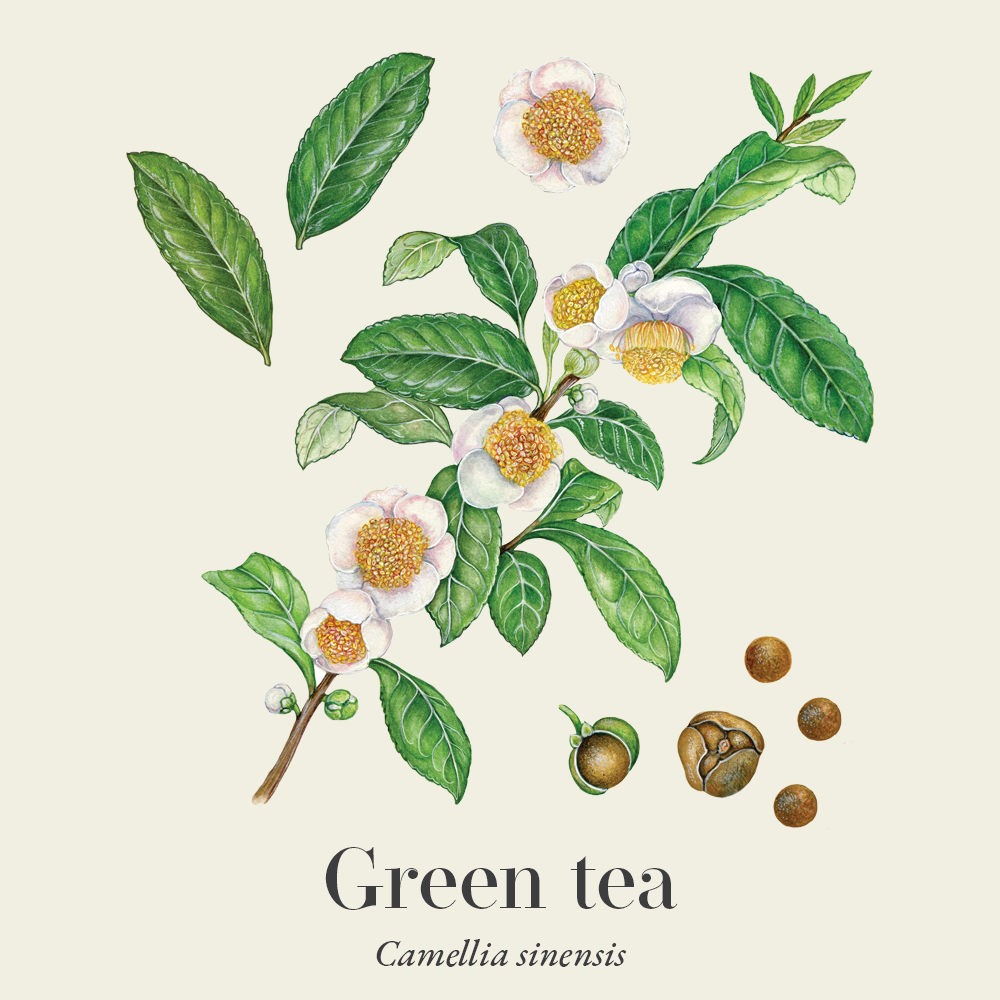
-
Habitat
Tea is an evergreen shrub native to East Asia and possibly originating in the borderlands of northern Burma and southern China. It has hybridised over at least 20,000 years and now most original wild varieties have disappeared. It is now mainly cultivated in China, India and Vietnam. It can grow to heights of 17 metres and is a tree in some locations. Its preferred habitat is evergreen forests and acidic soil, often growing best under the canopy of taller trees (28).
-
Sustainability

At risk from overharvesting and habitat loss. Read more in our sustainability guide. The IUCN red list of at risk species includes Camellia sinensis in their database. However it is listed as ‘data deficient’ due to the fact that its native wild distribution is unknown (29). Green tea is often commercially cultivated on a grand scale and provides support for small scale farmers globally (30).
Habitat loss and over-harvesting from the wild are two of the biggest threats faced by medicinal plant species. There are an increasing number of well-known herbal medicines at risk of extinction. We must, therefore, ensure that we source our medicines with sustainability in mind.
The herb supplement industry is growing at a rapid rate and until recent years a vast majority of medicinal plant produce in global trade was of unknown origin. There are some very real and urgent issues surrounding sustainability in the herb industry. These include environmental factors that affect the medicinal viability of herbs, the safety of the habitats that they are taken from, as well as the welfare of workers in the trade.
The botanical supply chain efforts for improved visibility (transparency and traceability) into verifiably sustainable production sites around the world is now certificated through the emergence of credible international voluntary sustainability standards (VSS).
Read our article on Herbal quality & safety: What to know before you buy and Sustainable sourcing of herbs to learn more about what to look for and questions to ask suppliers about sustainability.
-
Quality control
Herbal medicines are often very safe to take, however, their safety and efficacy can be jeopardised by quality issues — so, it is important to buy herbal medicines from a reputable supplier. Buying herbs from sources known to test their herbs to ensure there is no contamination, adulteration or substitution with incorrect plant matter. As well as ensuring that recognised marker compounds are at appropriate levels in the herbs.
Some important quality assurances to look for would be to look for certified organic labelling, ensuring that the correct scientific/botanical name is used and that suppliers can provide information about the source of ingredients used in the product.
A supplier should be able to tell you where the herbs have come from, what contaminants are not in the herb, and what primary compounds are.
-
How to grow
Camellia sinensis is fairly easy to grow. It can survive moderately cold temperatures such as those in the UK with plantations in both Scotland and Cornwall.
Bushes are grown from cuttings or clones which are carefully nurtured in nursery beds until ready for planting out.
Ideally plant in a partially shaded spot in moist, acidic soil. If the nature of the soil acidity is unknown this plant can also be grown in a pot in peat-free ericaceous compost.
For best results, grow in a sheltered area beside a wall, which will protect it from the harshest winter weather (31).
-
Recipe
Natural balance tea
When our digestive fire is low and our metabolism feels sluggish it cannot transform food into nourishing energy. Instead, food can get stored as fat, starting a vicious cycle where digestion becomes weaker and weaker, leading to steady weight gain. This delicious tea helps to stimulate the metabolism and supports your body to find your natural and balanced weight.

Green tea (Camellia sinensis) Ingredients
- Cinnamon bark 4 g
- Ginger root powder 2 g
- Orange peel 2 g
- Green tea 2 g
- Turmeric root powder 1 g
- Black pepper 1 g
- Orange essential oil a drop per cup
This will serve 2–3 cups of digestion enhancing, weight-balancing tea that works together with lots of exercise.
How to make a delicious green tea
- Put all of the ingredients in a pot (except for the orange essential oil).
- Add 500ml (18fl oz) freshly boiled filtered water. Leave to steep for 10–15 minutes, then strain.
- Add one drop of orange essential oil to each cup
-
References
- Chacko SM, Thambi PT, Kuttan R, Nishigaki I. Beneficial Effects of Green tea: a Literature Review. Chinese Medicine. 2010;5(1):13. https://doi.org/10.1186/1749-8546-5-13
- Thomsen M. Phytotherapy Desk Reference. 6th ed. Aeon Books; 2022.
- Wang S, Li Z, Ma Y, et al. Immunomodulatory Effects of Green Tea Polyphenols. Molecules. 2021;26(12). https://doi.org/10.3390/molecules26123755
- Zheng XX, Xu YL, Li SH, Liu XX, Hui R, Huang XH. Green tea intake lowers fasting serum total and LDL cholesterol in adults: a meta-analysis of 14 randomized controlled trials. The American Journal of Clinical Nutrition. 2011;94(2):601-610. https://doi.org/10.3945/ajcn.110.010926
- Yang CS, Chen G, Wu Q. Recent Scientific Studies of a Traditional Chinese Medicine, Tea, on Prevention of Chronic Diseases. Journal of Traditional and Complementary Medicine. 2014;4(1):17-23. https://doi.org/10.4103/2225-4110.124326
- Watson D. The Rich History of Green Tea: A Journey Through Time. Tea-and-Coffee.com. Published January 31, 2025. Accessed September 17, 2025. https://www.tea-and-coffee.com/blog/green-tea-history
- Mancini E, Beglinger C, Drewe J, Zanchi D, Lang UE, Borgwardt S. Green tea effects on cognition, mood and human brain function: A systematic review. Phytomedicine. 2017;34:26-37. https://doi.org/10.1016/j.phymed.2017.07.008
- Farkhondeh T, Pourbagher-Shahri AM, Ashrafizadeh M, et al. Green tea catechins inhibit microglial activation which prevents the development of neurological disorders. Neural Regeneration Research. 2020;15(10):1792-1798. https://doi.org/10.4103/1673-5374.280300
- Wasilewski R, Ubara EO, Klonizakis M. Assessing the effects of a short-term green tea intervention in skin microvascular function and oxygen tension in older and younger adults. Microvascular Research. 2016;107:65-71. https://doi.org/10.1016/j.mvr.2016.05.001
- Castellon X, Bogdanova V. Chronic Inflammatory Diseases and Endothelial Dysfunction. Aging and Disease. 2016;7(1):81-89. https://doi.org/10.14336/AD.2015.0803
- Sheng Y, Sun Y, Tang Y, et al. Catechins: Protective mechanism of antioxidant stress in atherosclerosis. Ethnopharmacology. 2023;14. https://doi.org/10.3389/fphar.2023.1144878
- Huang H, Guo Q, Qiu C, et al. Associations of green tea and rock tea consumption with risk of impaired fasting glucose and impaired glucose tolerance in Chinese men and women. PloS One. 2013;8(11):e79214. https://doi.org/10.1371/journal.pone.0079214
- Kondo Y, Goto A, Noma H, Iso H, Hayashi K, Noda M. Effects of Coffee and Tea Consumption on Glucose Metabolism: A Systematic Review and Network Meta-Analysis. Nutrients. 2018;11(1):48. https://doi.org/10.3390/nu11010048
- Payab M, Hasani‐Ranjbar S, Shahbal N, et al. Effect of the herbal medicines in obesity and metabolic syndrome: A systematic review and meta‐analysis of clinical trials. Phytotherapy Research. 2019;34(3):526-545. https://doi.org/10.1002/ptr.6547
- Di Sotto A, Gullì M, Percaccio E, Vitalone A, Mazzanti G, Di Giacomo S. Efficacy and Safety of Oral Green Tea Preparations in Skin Ailments: A Systematic Review of Clinical Studies. Nutrients. 2022;14(15):3149. https://doi.org/10.3390/nu14153149
- Alexopoulos N, Vlachopoulos C, Aznaouridis K, et al. The acute effect of green tea consumption on endothelial function in healthy individuals. European Journal of Cardiovascular Prevention and Rehabilitation: Official Journal of the European Society of Cardiology, Working Groups on Epidemiology & Prevention and Cardiac Rehabilitation and Exercise Physiology. 2008;15(3):300-305. https://doi.org/10.1097/HJR.0b013e3282f4832f
- Lorenz M, Rauhut F, Hofer C, et al. Tea-induced improvement of endothelial function in humans: No role for epigallocatechin gallate (EGCG). Scientific Reports. 2017;7(1):2279. https://doi.org/10.1038/s41598-017-02384-x
- Venkatakrishnan K, Chiu HF, Cheng JC, et al. Comparative studies on the hypolipidemic, antioxidant and hepatoprotective activities of catechin-enriched green and oolong tea in a double-blind clinical trial. Food & Function. 2018;9(2):1205-1213. https://doi.org/10.1039/c7fo01449j
- Asbaghi O, Fouladvand F, Gonzalez MJ, Aghamohammadi V, Choghakhori R, Abbasnezhad A. The effect of green tea on C-reactive protein and biomarkers of oxidative stress in patients with type 2 diabetes mellitus: A systematic review and meta-analysis. Complementary Therapies in Medicine. 2019;46:210-216. https://doi.org/10.1016/j.ctim.2019.08.019
- Almatroodi SA, Almatroudi A, Khan AA, Alhumaydhi FA, Alsahli MA, Rahmani AH. Potential Therapeutic Targets of Epigallocatechin Gallate (EGCG), the Most Abundant Catechin in Green Tea, and Its Role in the Therapy of Various Types of Cancer. Molecules. 2020;25(14):3146. https://doi.org/10.3390/molecules25143146
- Bolton D. Global Tea Production 2015. World Tea News. Published October 4, 2016. Accessed September 17, 2025. https://www.worldteanews.com/Features/global-tea-production-2015
- Hu J, Webster D, Cao J, Shao A. The safety of green tea and green tea extract consumption in adults – Results of a systematic review. Regulatory Toxicology and Pharmacology. 2018;95:412-433. https://doi.org/10.1016/j.yrtph.2018.03.019
- Natural Medicines. Green Tea. naturalmedicines.therapeuticresearch.com. Published 2024. https://naturalmedicines.therapeuticresearch.com/databases/food
- European Food Safety Authority. Scientific opinion on the safety of green tea catechins. European Food Safety Authority. Published April 18, 2018. Accessed September 6, 2024. https://www.efsa.europa.eu/en/efsajournal/pub/5239#:~:text=The%20Panel%20concluded%20that%20catechins
- Younes M, Aggett P, Aguilar F, et al. Scientific opinion on the safety of green tea catechins. EFSA Journal. 2018;16(4). https://doi.org/10.2903/j.efsa.2018.5239
- Graham HN. Green tea composition, consumption, and polyphenol chemistry. Preventive Medicine. 1992;21(3):334-350. https://doi.org/10.1016/0091-7435(92)90041-f
- Kanlaya R, Thongboonkerd V. Molecular Mechanisms of Epigallocatechin-3-Gallate for Prevention of Chronic Kidney Disease and Renal Fibrosis: Preclinical Evidence. Current Developments in Nutrition. 2019;3(9). https://doi.org/10.1093/cdn/nzz101
- Royal Botanical Gardens Kew. Tea plant – Camellia sinensis | Plants | Kew. www.kew.org. https://www.kew.org/plants/tea-plant
- Malin Rivers (IUCN SSC Global Tree Specialist Group / Botanic Gardens Conservation International DH, International (BGCI)) LW (Botanic GC. IUCN Red List of Threatened Species: Camellia sinensis. IUCN Red List of Threatened Species. Published online March 27, 2015. https://www.iucnredlist.org/species/62037625/62037628
- Andersen M. The Comprehensive Guide To Camellia Sinensis: Cultivation, Benefits, And Cultural Significance. JYYNA. Published August 15, 2024. https://jyyna.co.uk/camellia-sinensis/
- Tetyana Rotor. A Beginner’s Guide of How to Grow Your Own Tea Garden: Camellia sinensis Essentials. Cambridge Bee. Published May 2023. Accessed September 6, 2024. https://www.cambridgebee.com/blogs/news/a-beginners-guide-of-how-to-grow-your-own-tea-garden-camellia-sinensis-essentials?srsltid=AfmBOopE1D1SYH2rPgXesXsX_4m44wbKC_CbuPNyLlgnj9Y1sw3t4_TH


